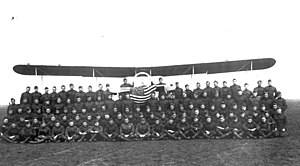8th Aero Squadron
| 8th Aero Squadron | |
|---|---|

8th Aero Squadron, Saizerais Aerodrome, France, 11 November 1918
|
|
| Active | 21 June 1917 – 25 May 1919 |
| Country |
|
| Branch |
|
| Type | Squadron |
| Role | Corps Observation |
| Part of | American Expeditionary Forces (AEF) |
| Engagements |
World War I |
| Commanders | |
| Notable commanders |
Capt. John G. Winant |
| Insignia | |
| 8th Aero Squadron Emblem |  |
| Aircraft flown | |
| Reconnaissance | Dayton-Wright DH-4, 1918-1919 |
| Trainer | Curtiss JN-4, 1917 |
| Service record | |
|---|---|
| Operations |
IV Corps Observation Group
|
IV Corps Observation Group
VI Corps Observation Group
Western Front, France: 14 August-11 November 1918
The 8th Aero Squadron was a Air Service, United States Army unit that fought on the Western Front during World War I.
The squadron was assigned as a Corps Observation Squadron, performing short-range, tactical reconnaissance over the IV Corps, United States First Army sector of the Western Front in France, providing battlefield intelligence. IV Corps was transferred to the United States Second Army in October 1918 for a planned offensive drive on Metz which was cancelled due to the 1918 Armistice with Germany on 11 November.
The squadron returned to the United States in June 1919 and became part of the permanent United States Army Air Service in 1921, being re-designated as the 8th Squadron (Surveillance) .
The current United States Air Force unit which holds its lineage and history is the 8th Special Operations Squadron, assigned to the 1st Special Operations Wing, Hurlburt Field, Florida.
The 8th Aero Squadron was drawn from enlisted personnel of the 2d Company "I" Provisional aviation camp, Kelly Field, Texas. After a short period of training at Kelly Field, the squadron boarded a train and was moved to Selfridge Field, Michigan, on 5 July 1917. Together with the 9th Aero Squadron, the 8th helped to construct the new flying field. For three and one-half months, the 8th Aero Squadron was engaged in training. Flight Cadets, Aviation Mechanics, fitters and riggers learned their basic skills. At Selfridge, the flight cadets completed primary aviation flight training, including soloing on Curtiss JN-4 "Jenny" trainers.
...
Wikipedia
